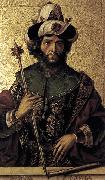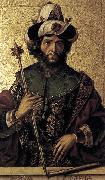
Oil On
Canvas, Real Flavor of Old Masters
|
Andrea della Verrocchio
|
|||
|
|
|||
| 1435-1488 Italian Andrea della Verrocchio Gallery | |||
|
|
|||
|
|
David new16/Andrea della Verrocchio-797844.jpg Painting ID:: 44853 Visit European Gallery |
mk176 c.1470 Bronze | |
Height Width |
INS/CM |
||
|
X |
|
||
|
|
|||
|
Francisco de Zurbaran
|
|||
|
|
|||
| 1598-1664 Spanish Francisco de Zurbaran Galleries Spanish baroque painter, active mainly at Llerena, Madrid, and Seville. He worked mostly for ecclesiastical patrons. His early paintings, including Crucifixion (1627; Art Inst., Chicago), St. Michael (Metropolitan Mus.), and St. Francis (City Art Museum, St. Louis), often suggest the austere simplicity of wooden sculpture. The figures, placed close to the picture surface, are strongly modeled in dramatic light against dark backgrounds, indicating the influence of Caravaggio. They were clearly painted as altarpieces or devotional objects. In the 1630s the realistic style seen in his famous Apotheosis of St. Thomas Aquinas (1631; Seville) yields to a more mystical expression in works such as the Adoration of the Shepherds (1638; Grenoble); in this decade he was influenced by Ribera figural types and rapid brushwork. While in Seville, Zurbur??n was clearly influenced by Velazquez. After c.1640 the simple power of Zurbaran work lessened as Murillo influence on his painting increased (e.g., Virgin and Child with St. John, Fine Arts Gall., San Diego, Calif.). There are works by Zurbar??n in the Hispanic Society of America, New York City; the National Gallery, Washington, D.C.; and the Philadelphia Museum of Art.. | |||
|
|
|||
|
|
david new22/Francisco de Zurbaran-998492.jpg Painting ID:: 65730 Visit European Gallery |
1641-1658 oiln on canvas private collection, madrid se | |
Height Width |
INS/CM |
||
|
X |
|
||
|
|
|||
|
Pedro Berruguete
|
|||
|
|
|||
| (c. 1450 - 1504) was a Spanish painter; his art is regarded as a transitional style between gothic and Renaissance. Born in Paredes de Nava, Spain, he went to Italy in 1480 and worked in Federigo da Montefeltro's court in Urbino, where he could see some works by Melozzo da Forle. He came back to Spain in 1482 and painted in several cities, such as Sevilla, Toledo and Ávila. He was the father of an important sculptor, Alonso Berruguete, considered the most important sculptor in Renaissance Spain. | |||
|
|
|||
|
|
David new24/Pedro Berruguete-988469.jpg Painting ID:: 78657 Visit European Gallery |
ca. 1500(1500) Medium Oil on wood cyf | |
Height Width |
INS/CM |
||
|
X |
|
||
|
|
|||
|
Pedro Berruguete
|
|||
|
|
|||
| (c. 1450 - 1504) was a Spanish painter; his art is regarded as a transitional style between gothic and Renaissance. Born in Paredes de Nava, Spain, he went to Italy in 1480 and worked in Federigo da Montefeltro's court in Urbino, where he could see some works by Melozzo da Forle. He came back to Spain in 1482 and painted in several cities, such as Sevilla, Toledo and Ávila. He was the father of an important sculptor, Alonso Berruguete, considered the most important sculptor in Renaissance Spain. | |||
|
|
|||
|
|
David new24/Pedro Berruguete-458535.jpg Painting ID:: 79327 Visit European Gallery |
. 1500(1500) Medium Oil on wood cyf | |
Height Width |
INS/CM |
||
|
X |
|
||
|
|
|||










